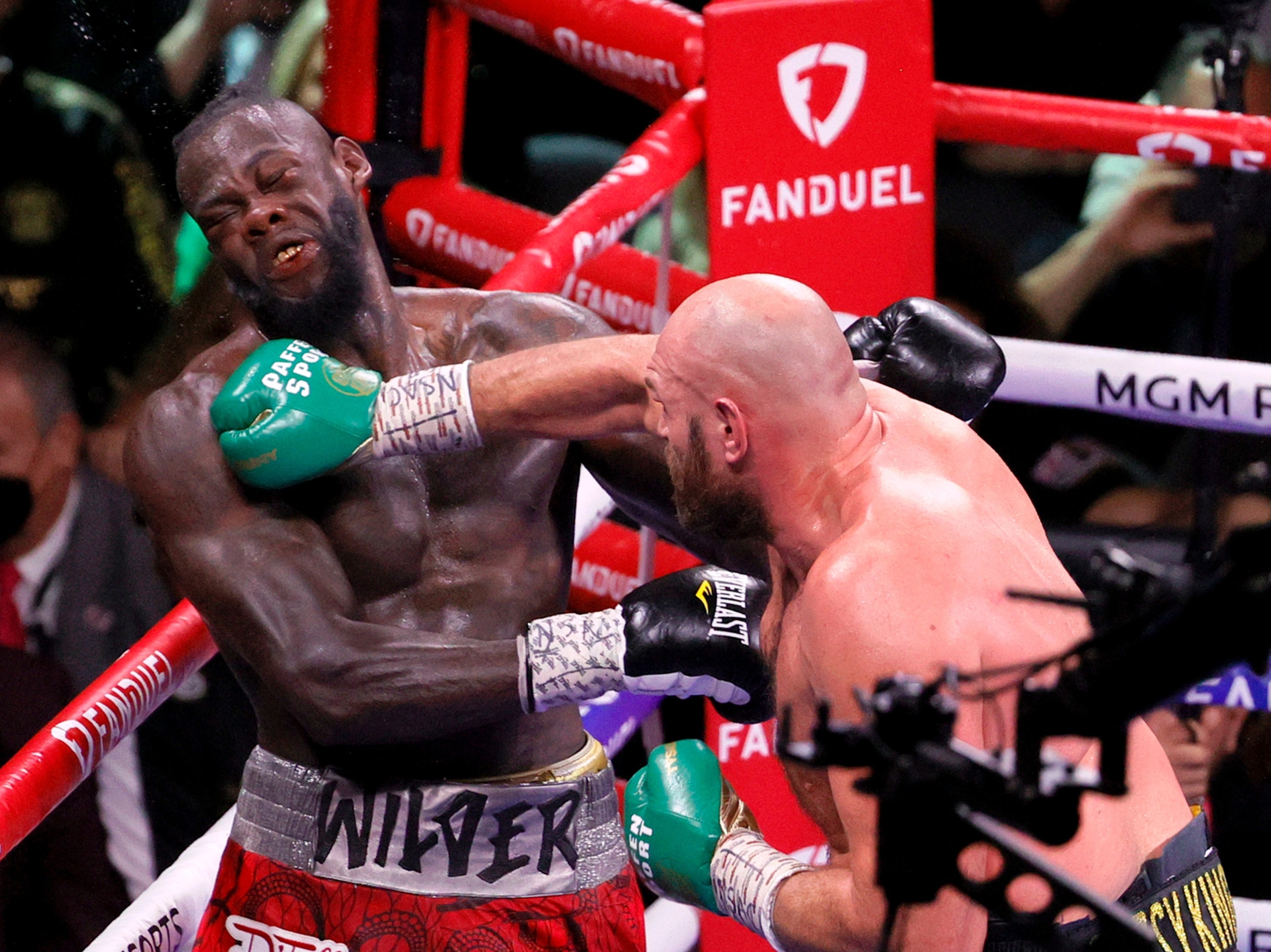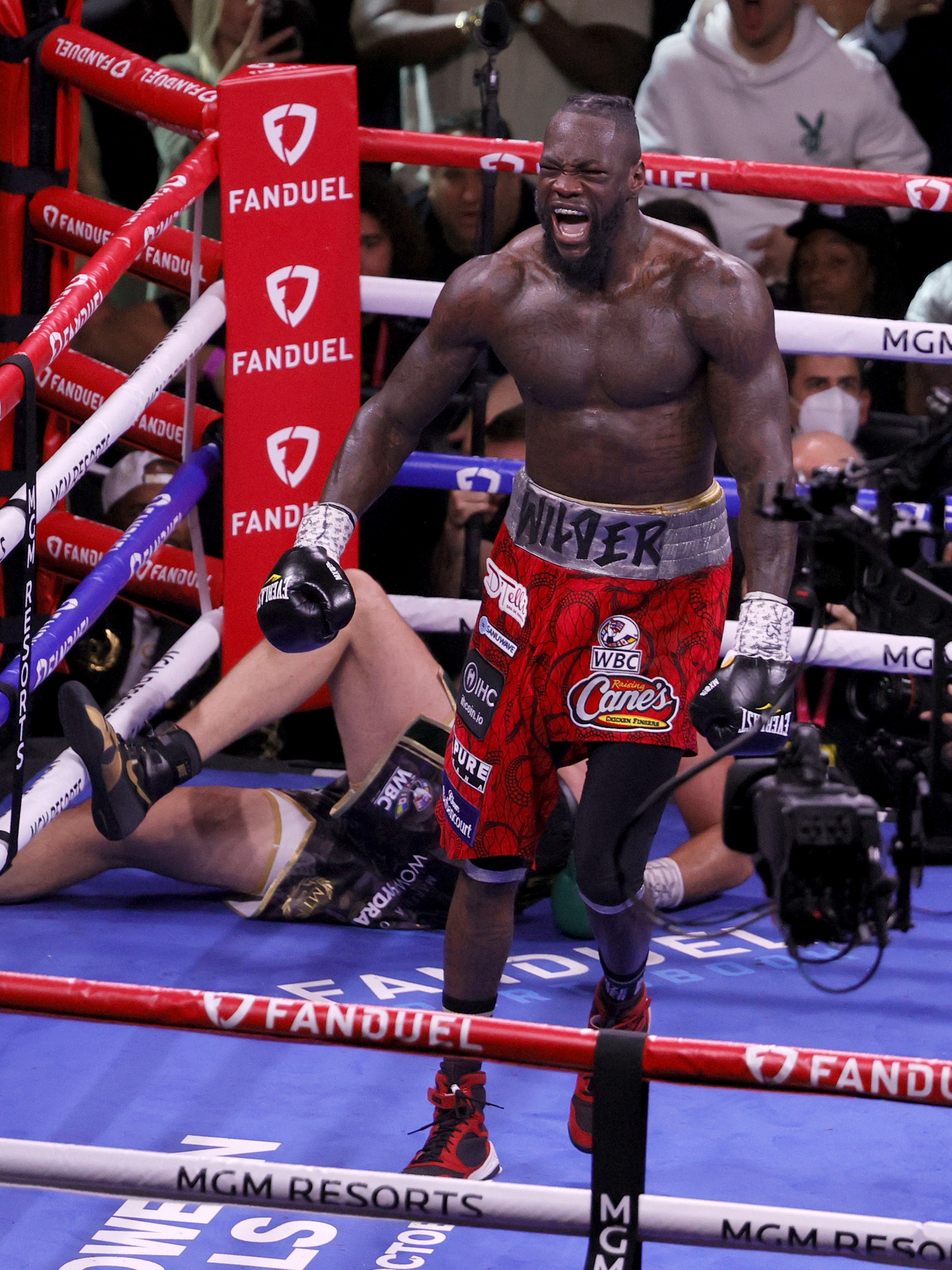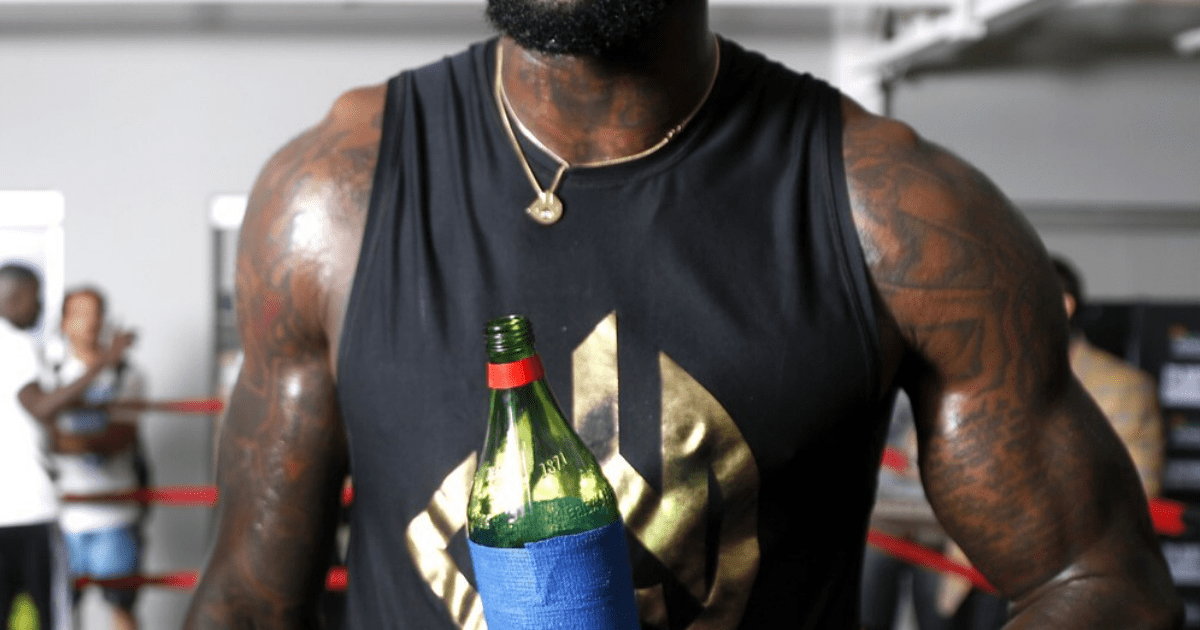DEONTAY WILDER is heading into his October 15 fight with Robert Helenius having undergone a stunning body transformation.
The American, 36, is making his return to the ring after losing his WBC heavyweight title trilogy with Tyson Fury last October.
Wilder is coming in leaner for his fight with Helenius
The American expects to come in around the 220s for his October fight
 Wilder says he felt ‘sluggish’ against Fury last year
Wilder says he felt ‘sluggish’ against Fury last year

Wilder weighed in at 238lbs for his final fight with Fury
And he’s coming into the Barclays Center clash leaner, having shedded weight during his time away from boxing.
Wilder weighed in at 238lbs for his last fight against Fury.
But the Alabama-born hard hitter says he’ll come in at somewhere in the 220s for Helenius.
Wilder said during his virtual press conference: “Somewhere in the 220s, somewhere around there.
“The weight isn’t what we’re going to worry about in this fight or in fights in the future.
“We gained a lot of weight for the last fight for others’ expectations to see my body a certain way.
“I was interested in seeing my body frame at a certain weight as well.
“At this moment in time, I’m going back to what I’m used to and most comfortable to me and what’s comfortable to my body frame, and that’s going to be around the 220s or maybe under.”
Wilder says he felt “a little heavy” against Fury.
He added: “Yeah, I felt a little sluggish, a little heavy.
“You have to understand that I’ve never been 240 ever in my life before, but it was an experiment that I wanted to try.
“We did what we had to do to get the weight put on there, and that’s an experience in the history books for me.
“The only way to become wise is to apply knowledge to life, and we gained a lot of knowledge from that, and now we know what to do moving forward.”
Should Wilder get past Helenius, he has ambitions of fighting the top three heavyweights before retiring.
Wilder wants to take on Fury in a fourth fight – despite losing twice and drawing once already.
And he would like a slice of AJ as well as WBA, IBF, WBO and IBO champ Usyk.
Wilder claimed a fourth fight with Fury is ‘”inevitable” and a showdown with Joshua “will get done when it’s time”.
A meeting with Usyk has already being called for by the Ukrainian.
Once his return is complete, Wilder will then retire to focus on making music.
Frequently Asked Questions
How to throw the jab
Follow this step-by-step guide to throw a jab.
- With both feet, move forward
- Move your arm to the top of your shoulder.
- Bring your fist down towards your target.
- After hitting your target, raise your arm upwards.
- Steps 1 through 4 can be repeated.
What are the various types of boxing gloves available?
There are three main types in boxing gloves: mitts; fingerless mitts; and full-fingerered. The padding around the knuckles of mitten gloves is called padding. Fingerless mitts have no padding around the knuckles but still cover the fingers. Full-fingered gloves have padding around the entire of the hand.
For punching with the fist, mittens can be used. Fingerless mitt gloves, also known as fingerless mitts, are used to punch or strike with the index finger’s knuckle. Boxing gloves that are full-fingered can be used to punch with your whole fist.
How long does it take to learn to box?
Boxing can be considered one of the oldest and most well-known martial arts. Around 2200 BC, China hosted the first boxing match. Since thousands of years, boxing is a well-known sport. Today, boxing is still popular among athletes and celebrities. However, it takes about 10 months to become proficient at boxing.
It is difficult to learn boxing because there are so many movements. Each movement requires specific muscles to perform properly. It takes time and effort to build these muscles.
However, once you know how to move your entire body, you can then start any type of boxing technique. You’ll get better at each technique over time.
What are the 7 punches in boxing?
These seven punches are: jab cross, hook hook, uppercut straight right, left hook and body shot. These punches can be used to strike the opponent’s head and body.
How much weight do I need to lift for a good workout?
If you are looking to increase your strength, weight lifting is a must. There are some things you need to remember when lifting weights. First, make sure that you don’t overdo it. Aim to lift heavierweights every other days. Third, complete each exercise 8 times. Fourth, between sets, take 2 minutes to rest. Fifth, do all exercises without momentum. Finally, be focused on form, not speed.
Statistics
- It is just like normal sparring with a partner, but you want to throw punches at 75% of your normal speed. (wikihow.com)
- This article received 39 testimonials and 89% of readers who voted found it helpful, earning it our reader-approved status. (wikihow.com)
External Links
en.wikipedia.org
amazon.com
- Amazon.com : Ringside Diablo Wrestling Boxing Boots : Clothing, Shoes & Jewel
- Amazon.com – Sanabul Boxing Gloves Elastic 180 Inch Red : Outdoors & Sports
How To
Here are some basic skills in boxing
How to box effectively
Boxing is one of the most popular sports in the world. It consists of two opponents who try to knock out each other’s head. Boxing rules vary from one country or another. In general, there are three types of boxing; Amateur, Professional and Olympic boxing.
Amateur boxing may be done at school, college, and university. This type includes sparring sessions using padded gloves, but without protection. Amateur boxing competitions usually last three rounds and last five minutes each. There are many styles to amateur boxing like Kickboxing. Muay Thai. Taekwondo. Karate. Judo. Wrestling.
Boxing is often practiced in gyms or clubs. They use protective equipment, such as mouthpieces, nose guards, shin protectors, elbow pads knee pads, waist belts and groin protectors. Professional boxing competitions include six rounds of four minutes each. There are many different types of professional Boxing such as Boxing, MMA, Kickboxing, Muay Thai or Taekwondo.
Olympic boxing is performed at the Olympics. Boxers are required to wear international standards-compliant protective gear. The competition lasts approximately three minutes for each round. Olympic boxing has only two styles, Light Flyweight vs Heavyweight.
Boxing is based on the following skills:
- Punching techniques
- Techniques for protecting yourself
- Footwork
- Stance
- Movement of the body
- Defense
- Combination
- Rotation
- Spares
Punching Techniques
There are seven types of punches available: Left Hook and Right Hook, Cross, Cross, Straight, Underhand, Overhand, Cross, Straight, Cross, Straight, Cross, Straight, and Overhand. Each punch has its own technique. Some punches are more powerful than others. For example, an uppercut requires great force. On the other hand, a straight punch requires less power but it is faster than other punches.
There are many combinations of punches. These are combinations that combine punches to accomplish a particular goal. A combination may have multiple parts. An example of this is a left hook, followed by a right crossing. This will damage the opponent’s jaw.
Guard Techniques
A boxer protects himself by using his body. He does this by using his legs.
Legs
To defend against kicks, a boxer should use his legs. When he’s hit, he raises his right leg and runs away from the attacker. To avoid being kicked in the side, he bends down if the attacker attacks from the front. He will block the kick with his foot if the attack is coming from behind.
Elbows
Because elbow strikes inflict a lot of pain, they are very effective. You can either deliver an elbow strike directly, or indirectly. Directly means that your opponent is hit with your forearm. However, indirectly means that your elbow strike is delivered with another part or your arm.
Hands
Boxers use their hands to block incoming blows. They raise their fists high above their heads and point them in the direction of an attack. Then, they touch the attacker’s hand.
Knees
When receiving a blow to the stomach, abdomen or chest, a boxer should bend his knees to absorb the impact. Knee strikes are often used for defense purposes.
Feet
If he is being attacked, a boxer must take a step back and counter-attack. This will allow him to gain distance from his opponent. Boxers should also keep their balance when counter-attacking.
Stances
Boxing effectively requires a boxer to have a good stance. His stance will determine how he defends. It dictates how he places his body and faces his opponent. Boxers have many options for stances. Here are the most commonly used ones:
- A low stance
- High stance
- Southpaw stance
- Western stance
Move your body
To win a fight, a fighter must move around the opponent. This involves changing positions, speed, rhythm and timing.
Rotation
When a boxer throws a punch, he rotates in order to increase the reach of his arm. Depending on the type and size of punch, the speed at which the rotation takes place varies.
Combinations
The timing of each individual punch affects the effectiveness or failure of a combination. A good combination starts with a strong punch and ends with a weak one.
Spare parts
Sparring is a training session that improves boxing skills. Sparring is a training session that helps a boxer train his mind and body. Sparring, in conclusion, is about learning how to fight and not getting hurt.
It is important to be patient and dedicated when learning how to box. To become a better boxer, you must train hard and for a long time.

